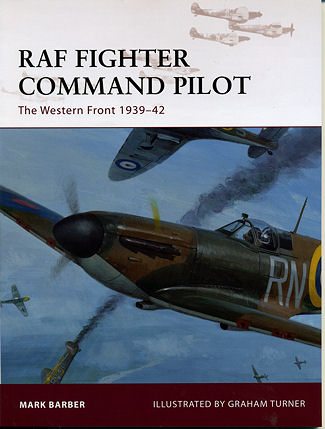 This
latest Osprey book in their Warrior series is about the RAF Fighter Command
Pilot. Unlike the Germans during WWII, the RAF did not have a lot of active duty
pilots when the war was imminent. What they did have was a goodly number of
reserve pilots. These folks would fly on occasion in order to keep up their
skills and would have a couple of weeks of active work during the summer to
ensure readiness. When the war started, these folks were called up to their
respective units and were important assets in the opening stages. As the war
progressed, pilots from countries over-run by the Germans found their way to
England and they, too were used in the fighting.
This
latest Osprey book in their Warrior series is about the RAF Fighter Command
Pilot. Unlike the Germans during WWII, the RAF did not have a lot of active duty
pilots when the war was imminent. What they did have was a goodly number of
reserve pilots. These folks would fly on occasion in order to keep up their
skills and would have a couple of weeks of active work during the summer to
ensure readiness. When the war started, these folks were called up to their
respective units and were important assets in the opening stages. As the war
progressed, pilots from countries over-run by the Germans found their way to
England and they, too were used in the fighting.
The UK also had a wide commonwealth of nations that provided
qualified pilots and you found Canadians, Australians, New Zealanders and South
Africans in the RAF. You also found pilots from countries not yet involved in
the war such as the United States and Argentina, for example.
In the beginning, these highly trained men bore the brunt of the
fighting in France and later during the Battle of Britain. But it was obvious
the more pilots were needed, so training was streamlined. It was not uncommon
for newly trained pilots to have only flown Hurricanes or Spitfires for a few
hours and more than just a few had never fired the guns! This showed a real
deficiency and the training syllabus was in a major state of flux. Few of these
new pilots were trained in tactics and those that were used in the beginning
were soon shown to be woefully out of date. This was changed from the bottom up
as units learned what worked and what did not. Eventually, training evolved into
the BCTP, or the British Commonwealth Training Plan held at bases throughout the
commonwealth. Prior to the entry of the US into the war, many British and
commonwealth pilots were trained in the US, though ostensibly as 'civilians'.
In this book on the RAF fighter pilot, the author looks at how RAF
fighter command operated in the inter-war period, It then goes into what it took
to be a fighter pilot and the evolution of their training. A section on their
flying clothing and uniforms is next, followed by a look at the major aircraft
types of Fighter Command in the first few years of the war. This is then
followed by the conditions under which these men operated. Initially, they flew
without relief, but once the BoB was over, they were able to fly on a more
regular schedule and this included down times to re-train and perhaps move on to
new types. This is then followed by a section on the tactics of aerial combat
and how these changed during these early years. It ends with a short list of
major UK museums where these aircraft can be seen today.
January 2009
For more on the complete line of Osprey books,
visit www.ospreypublishing.com
or contact them at Osprey Direct, PO Box 140, Wellingborough, Northants,
NN8 2FA, UK. In the US, it is
Osprey Direct at 443 Park Avenue South, New York, NY 10016, where you can
get a catalogue of available books.
If you would like your product reviewed fairly and quickly, please
contact
me or see other details in the Note to
Contributors.
 This
latest Osprey book in their Warrior series is about the RAF Fighter Command
Pilot. Unlike the Germans during WWII, the RAF did not have a lot of active duty
pilots when the war was imminent. What they did have was a goodly number of
reserve pilots. These folks would fly on occasion in order to keep up their
skills and would have a couple of weeks of active work during the summer to
ensure readiness. When the war started, these folks were called up to their
respective units and were important assets in the opening stages. As the war
progressed, pilots from countries over-run by the Germans found their way to
England and they, too were used in the fighting.
This
latest Osprey book in their Warrior series is about the RAF Fighter Command
Pilot. Unlike the Germans during WWII, the RAF did not have a lot of active duty
pilots when the war was imminent. What they did have was a goodly number of
reserve pilots. These folks would fly on occasion in order to keep up their
skills and would have a couple of weeks of active work during the summer to
ensure readiness. When the war started, these folks were called up to their
respective units and were important assets in the opening stages. As the war
progressed, pilots from countries over-run by the Germans found their way to
England and they, too were used in the fighting.